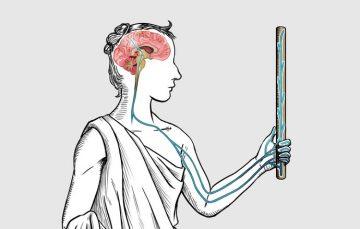Richard Sima in Scientific American:
 Luke Miller, a cognitive neuroscientist, was toying with a curtain rod in his apartment when he was struck by a strange realization. When he hit an object with the rod, even without looking, he could tell where it was making contact like it was a sensory extension of his body. “That’s kind of weird,” Miller recalls thinking to himself. “So I went [to the lab], and we played around with it in the lab.”
Luke Miller, a cognitive neuroscientist, was toying with a curtain rod in his apartment when he was struck by a strange realization. When he hit an object with the rod, even without looking, he could tell where it was making contact like it was a sensory extension of his body. “That’s kind of weird,” Miller recalls thinking to himself. “So I went [to the lab], and we played around with it in the lab.”
Sensing touch through tools is not a new concept, though it has not been extensively investigated. In the 17th century, philosopher René Descartes discussed the ability of blind people to sense their surroundings through their walking cane. While scientists have researched tool use extensively, they typically focused on how people move the tools. “They, for the most part, neglected the sensory aspect of tool use,” Miller says.
In a 2018 Nature study, Miller and his colleagues at Claude Bernard Lyon 1 University in France reported that humans are actually quite good at pinpointing where an object comes into contact with a handheld tool using touch alone, as if the object were touching their own skin. A tool is not innervated like our skin, so how does our brain know when and where it is touched? Results in a follow-up study, published in December in Current Biology, reveal that the brain regions involved with sensing touch on the body similarly processes it on the tool. “The tool is being treated like a sensory extension of your body,” Miller says.
More here.
